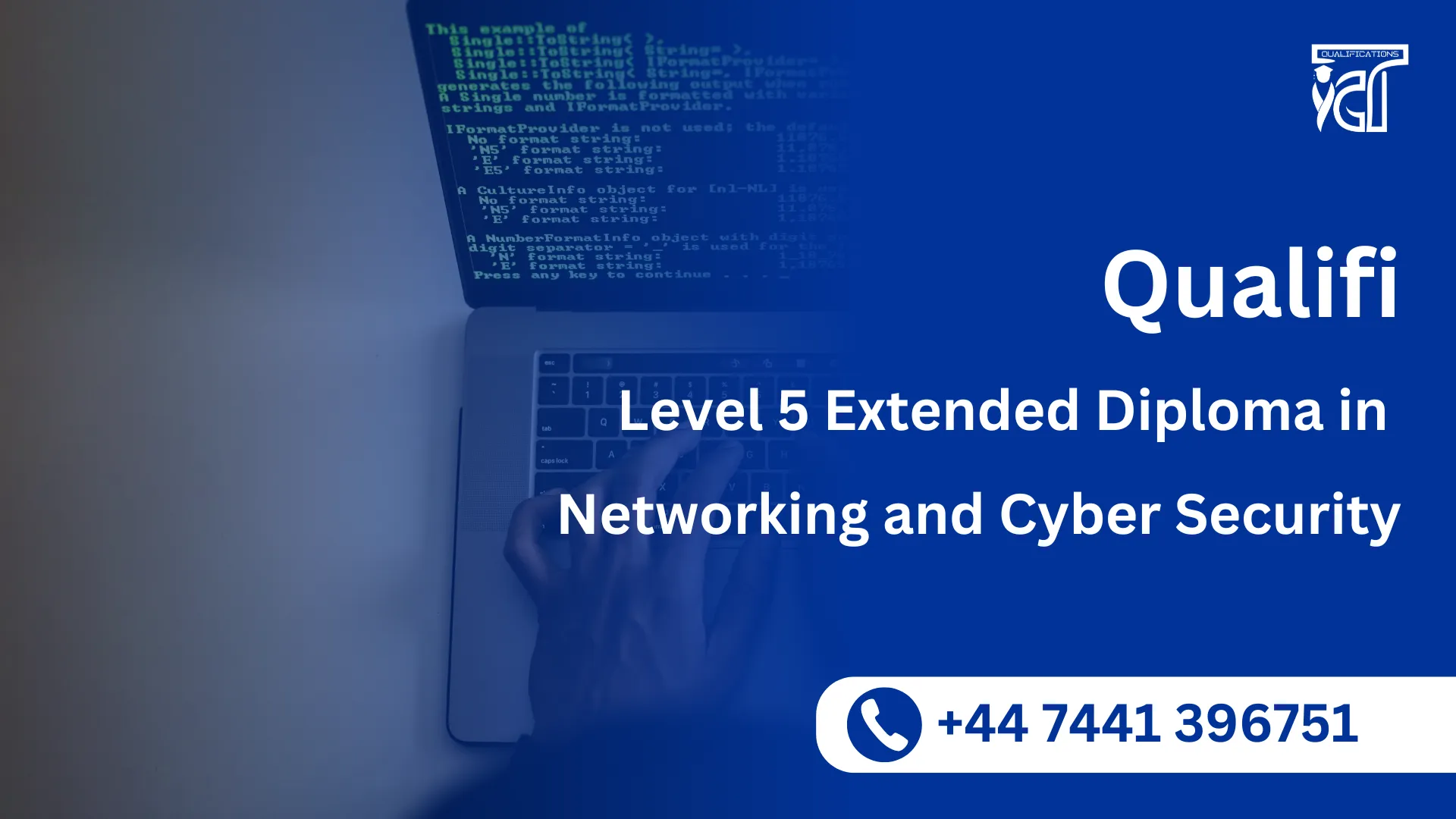In an era dominated by digital transformation, the importance of robust networking and cyber security has never been greater. Organisations worldwide are continuously seeking skilled professionals who can safeguard their networks and data from evolving cyber threats. The Qualifi Level 4 and Level 5 Combined Diploma in Networking and Cyber Security is an advanced qualification designed to equip learners with comprehensive knowledge and practical skills in these critical areas.
This Ofqual-regulated diploma is internationally recognised and ideal for IT professionals and aspiring cyber security experts who want to enhance their career prospects and meet industry standards.
The Qualifi Level 4 and Level 5 Combined Diploma in Networking and Cyber Security offers a thorough exploration of networking technologies and cyber security practices. This combined diploma equips learners with the ability to design, implement, and manage secure networks while understanding the key principles of protecting information systems against cyber threats.
The course curriculum balances theoretical foundations with hands-on practical learning, ensuring graduates are job-ready and capable of addressing real-world security challenges.
This combined diploma integrates the essential components of Level 4 and Level 5 qualifications, providing a seamless learning pathway. Topics covered include network infrastructure, cyber security principles, ethical hacking, penetration testing, incident response, and information security governance.
Learners will engage with a variety of learning modules designed to develop both technical proficiency and strategic understanding of cyber security frameworks.
The Qualifi Level 4 and Level 5 Combined Diploma in Networking and Cyber Security provides a comprehensive foundation and advanced expertise to excel in the dynamic and high-demand field of cyber security. With a curriculum designed to meet industry needs and flexible study options, this qualification is an excellent investment for those aspiring to protect digital environments and advance their IT careers.
Qualifi Level 5 Extended Diploma in Networking and Cyber Security consists of 11 mandatory units having 2400 TQT and 1200 GLH. Learners must complete all mandatory units to achieve 240 Credits.
- Cyber Security Threat and Risk
- Network Security and Data Communications
- Database Security and Computer Programming
- Incident Response, Investigations and Forensics
- Security Strategy: Laws, Policies and Implementation
- Physical IT Networking
- Cryptography
- Digital Investigations and Forensics
- System Administration
- Network Routing and Switching
- Network Design and Administration
GLH (Guided Learning Hours) and TQT (Total Qualification Time) are terms commonly used in vocational qualifications to help define the amount of time a learner is expected to spend on their studies.
1. GLH (Guided Learning Hours)
GLH refers to the number of hours a learner spends being directly taught, supervised, or supported during their course. This includes the time spent in activities such as:
- Classroom instruction
- Practical workshops
- One-on-one tutoring or mentoring sessions
- Online learning sessions with tutor support
In other words, GLH represents the time that learners are actively engaged with their instructors or learning activities.
2. TQT (Total Qualification Time)
TQT represents the total amount of time a learner is expected to invest in completing a qualification, including:
- GLH (Guided Learning Hours): Time spent on direct learning, as explained above.
- Self-Directed Learning: This includes time spent on independent study, research, assignment completion, preparation for exams, and any other work the learner does outside of direct teaching hours.
TQT is a broader measure that includes all the time required to achieve the qualification. It helps learners and employers understand the overall commitment required for the qualification.
Key Differences Between GLH and TQT:
- GLH focuses on direct learning with guidance or supervision.
- TQT includes GLH as well as independent study time and other learning-related activities.
Example:
If a qualification has a TQT of 600 hours and a GLH of 250 hours, it means the learner should spend 250 hours in direct learning (classroom, online, or tutor-led sessions) and 350 hours on independent study or research.
Learning Outcomes of Qualifi Level 4 and Level 5 Combined Diploma in Networking and Cyber Security:
Cyber Security Threat and Risk
- Understand complex business cyber security threats and risks.
- Understand recent mega breaches and explain malware and ransomware attacks.
- Understand how threats and malicious hackers are advancing and developing customised intrusion tools.
Network Security and Data Communications
- Understand how computers and digital devices communicate with one another over a network.
- Understand, at a strategic level how computer networking, web applications and software can be exploited.
- Understand methods of security prevention and systems hardening.
- Understand key network security and systems resilience tools, terminology and models.
Database Security and Computer Programming
- Understand the broad range of information security controls to protect databases.
- Understand types of database categories of control.
- Understand the underpinning concepts and models of cloud-based storage solutions.
- Understand the relationship between computer programming and computer hacking.
- Understand the ‘interpreted’ general purpose programming language, Python.
Incident Response, Investigations and Forensics
- Understand the role and composite parts of Incident Response as a business function and how CERTS operate.
- Understand aligned task/task forces for Business Continuity, Disaster Recovery and Crisis Management.
- Understand how major computer incidents are formally investigated.
- Understand laws and guidance in relation to the conduct of planned and structured major incident investigations.
Security Strategy: Laws, Policies and Implementation
- Understand the concept of strategy, strategic management, planning and buy-in in relation to cyber security.
- Understand how legislation, formal industry standards, training and accreditations support cyber security.
- Understand how to implement Plan, Do, Check and Act security and risk management policies.
- Understand the future legal and technical environment and the impact on cyber security planning and digital risk management.
- Understand how to plan and design a security audit for a cyber network.
Physical IT Networking
- Apply the components of physical networking.
- Understand the components and interfaces between different physical networking attributes.
- Install security protocols in a physical network.
Cryptography
- Understand key cryptographic principles and modes.
- Understand the standards, regulations and laws that apply to business and government organisations in relation to encryption.
- Design an encryption plan and courses of action for a given organisation.
Digital Investigations and Forensics
- Understand the core principles of digital investigations.
- Apply the types of tool that support professional digital investigations at a strategic level.
- Plan for an investigations and forensics teams.
- Understand the importance of safeguarding evidential integrity in digital investigations.
System Administration
- Understand system administration.
- Perform user management and file system management.
Network Routing and Switching
- Understand switching.
- Perform routing.
Network Design and Administration
- Understand network design.
- Configure a local area network and a VLAN.
- Administer a network.
Course Benefits of the Qualifi Level 4 and Level 5 Combined Diploma in Networking and Cyber Security:
Course Benefits
- Internationally Recognised Qualification
This Ofqual-regulated diploma is accepted worldwide, enhancing your professional credibility and opening global career opportunities. - Comprehensive Skill Development
Provides in-depth knowledge and practical skills in both networking and cyber security, preparing learners for diverse roles in IT. - Industry-Relevant Curriculum
Aligns with current industry standards and emerging trends, ensuring learners are equipped to handle modern cyber threats and network challenges. - Flexible, Assignment-Based Learning
Designed to accommodate working professionals and remote learners, with assessments based on practical assignments rather than exams. - Career Progression
Opens pathways to roles such as Network Engineer, Cyber Security Analyst, Ethical Hacker, and IT Security Consultant. - Foundation for Professional Certifications
Prepares learners to pursue advanced industry certifications like CISSP, CEH, CompTIA Security+, and more. - Enhances Problem-Solving and Analytical Skills
Develops critical thinking needed to identify vulnerabilities and implement effective security solutions. - Supports Organizational Security Needs
Equips professionals to protect sensitive data and maintain the integrity of IT infrastructures. - Strong Academic Progression
Provides a pathway to Level 6 qualifications and further academic advancement in cyber security and related fields.
Ideal Learner for the Qualifi Level 4 and Level 5 Combined Diploma in Networking and Cyber Security:
- IT Professionals seeking to specialise in networking and cyber security to advance their careers.
- Recent Graduates with a background in IT or computing aiming to build strong practical skills and industry-recognised qualifications.
- Career Changers interested in transitioning into the fast-growing fields of cyber security and network management.
- Network Administrators and Technical Support Staff looking to deepen their understanding of network security and cyber threat mitigation.
- Organisations aiming to upskill their IT teams and enhance their cyber defence capabilities.
- Students Preparing for Industry Certifications such as CISSP, CEH, and CompTIA Security+, who want a solid academic foundation.
- Remote Learners and Working Professionals needing flexible study options that fit around existing commitments.
Entry Requirements
Register Now
Qualification Process
Qualification Process for the Qualifi Level 4 and Level 5 Combined Diploma in Networking and Cyber Security
- Self-Assessment:
Begin by evaluating your eligibility to ensure you meet the qualification requirements, including work experience, knowledge, and language proficiency. - Registration:
Complete your registration by submitting the required documents, including a scanned copy of a valid ID, and paying the registration fee. - Induction:
An assessor will conduct an induction to confirm your eligibility for the course and explain the evidence requirements. If you do not meet the criteria, your registration will be canceled, and the fee will be refunded. - Assignments & Evidence Submission:
Provide all assignments and the necessary evidence based on the assessment criteria outlined in the course. If you are unsure of the required evidence, consult with the assessor for guidance on the type and nature of evidence needed. - Feedback and Revision:
The assessor will review your submitted evidence and provide feedback. Evidence that meets the criteria will be marked as “Criteria Met,” while any gaps will be identified. You will be asked to revise and resubmit if needed. - Competence Evidence:
Submit final evidence demonstrating that all learning outcomes have been met. This evidence will be marked as “Criteria Met” by the assessor once it is satisfactory. - Internal Quality Assurance (IQA):
The Internal Quality Assurance Verifier (IQA) will review your evidence to ensure consistency, quality, and compliance with standards. - External Verification:
The IQA will submit your portfolio to Qualifi’s External Quality Assurance Verifiers (EQA) for final confirmation. The EQA may contact you directly to verify the authenticity of your evidence. - Certification:
Upon successful completion of all checks, Qualifi will issue your official certificate, confirming that you have attained the Qualifi Level 4 and Level 5 Combined Diploma in Networking and Cyber Security.






